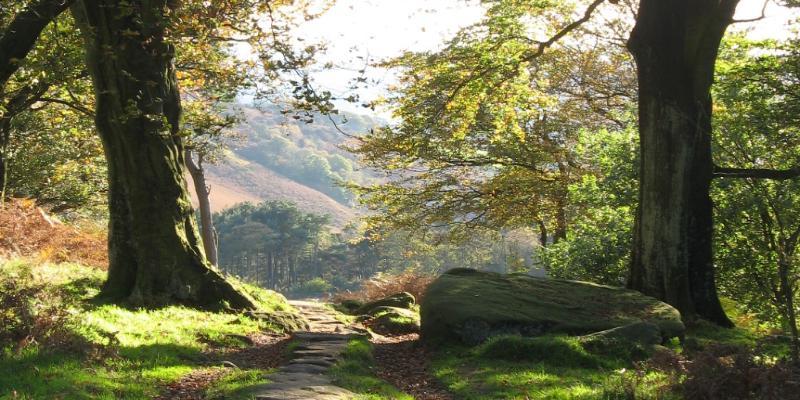
Connected Treescapes
A portfolio approach for delivering multiple public benefits from UK treescapes in the rural-urban continuum
Context
Trees and woodlands in the landscape (treescapes) play a key role in the UK’s economy and society. As well as being a source of timber and energy, they are important for biodiversity conservation and carbon sequestration. They improve our health and wellbeing, and are a key part of our heritage and culture.
Trees and woodlands are viewed increasingly as the single most effective nature-based solution to help reduce climate change. The UK Government has committed to plant 50 million new trees by 2050 to help us reach net zero carbon emissions, by removing carbon dioxide from the atmosphere. The range of demands and expectations on trees and woodlands is higher than ever before. The 3-year Connected Treescapes project will provide important new knowledge and understanding on how current decisions regarding treescapes today can secure and enhance this wide range of benefits from trees and woodlands for current and future generations.
The psychological connections between people and trees go back many centuries, and are important for our physical and mental health and wellbeing. Ecological connections between trees in the landscape play a vital role in protecting nature, helping populations of animals, plants and fungi to mix and remain healthy. An increasing number of people are visiting woodlands for their health and recreation benefits. Nevertheless, the changing climate means that trees and woodlands are at increasing threat from pests and disease, as well as from changes in temperature and rainfall.
Our project will shed new light on how landowners and other stakeholders across the landscape can work effectively toward the common goal of maintaining and improving our trees and woodlands, so that they continue to provide benefits for biodiversity and nature recovery, and health and wellbeing, while also helping to protect us from pollution and climate change. The project will be vital in helping to inform the ambition of net zero emissions by 2050.
Aims and objectives
The project will focus on the role that trees and woodlands play in and around the UK’s towns and cities. It is in the settings that the social and cultural benefits of trees and woodlands can be greatest, yet where they also face considerable environmental pressures. Our research will take a historical perspective, combining information on changes in trees and woodlands over the last three centuries with new information on their current and future importance for biodiversity and health and wellbeing under different climate change scenarios. We will combine a UK-level analysis with a focus on five initiatives cutting across urban and rural areas – the Mersey Forest, the National Forest, The National Forest of Wales, The Irish Border woodlands, and the Central Scotland Green Network.
The project has four specific objectives:
1. To explore how historical factors such as land use and ownership, and changing perceptions and expectations of treescapes, have combined with ecological factors to create the form and function of present-day treescapes
2. To evaluate how treescape form and function affects three key public benefits from treescapes: biodiversity and nature recovery; mental health and wellbeing; and cultural and heritage value
3. To analyse the opportunities, barriers and pathways for expansion of UK treescapes through landscape-level partnerships across the public, private and third sectors
4. To consider how the resilience of treescapes and the public benefits they provide can be increased in the face of local and global socio-economic and environmental risks.
Professor Piran White (Department of Environment and Geography, University of York)
Dr Julia Touza (Department of Environment and Geography, University of York)
Principal Investigators:
Professor Piran White (Department of Environment and Geography, University of York)
Dr Julia Touza (Department of Environment and Geography, University of York)
Co-Investigators:
Professor Jane Hill (Department of Biology, University of York)
Professor Jacco Thijssen (Department of Mathematics, University of York)
Professor Lisa Emberson (Department of Environment and Geography, University of York)
Dr Peter Coventry (Department of Health Sciences, University of York)
Dr Colin Beale (Department of Biology, University of York)
Professor Annie Tindley (School of History, Classics and Archaeology, Newcastle University)
Dr Glyn Jones (School of Natural and Environmental Sciences, Newcastle University)
My Guy Garrod (School of Natural and Environmental Sciences, Newcastle University)
Dr Clare Hickman (School of History, Classics and Archaeology, Newcastle University)
Dr Miles Richardson (College of Health, Psychology and Social Care, University of Derby)
Professor David Sheffield (Online Learning, University of Derby)
Dr Annie McKee (Social, Economic and Geographical Sciences, The James Hutton Institute)
Dr Kirsteen Shields (The Roslin Institute, University of Edinburgh)
Professor Adam Kleczkowski (Department of Mathematics and Statistics, University of Strathclyde)
Dr Vadim Saraev (Centre for Ecosystems, Society and Biosecurity, Forest Research)
Dr Bianca Ambrose-Oji (Centre for Ecosystems, Society and Biosecurity, Forest Research)
Dr Michael Pocock (UK Centre for Ecology and Hydrology)
Dr Lindsay Maskell (UK Centre for Ecology and Hydrology)
Future of UK Treescapes programme, funded by UK Research and Innovation, Natural Environment Research Council (NERC), Arts and Humanities Research Council (AHRC), Economic and Social Research Council (ESRC)
Newcastle University
University of Derby
The James Hutton Institute
University of Edinburgh
University of Strathclyde
Forest Research
UK Centre for Ecology and Hydrology
The Tree Council
The National Forest Company
The Mersey Forest Partnership
Woodland Trust Northern Ireland
Buccleuch Living Heritage Trust and Estates
Dufferin Foundation
Rothamsted Research
Butterfly Conservation